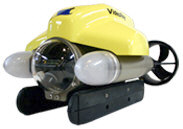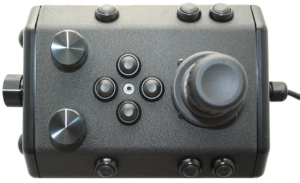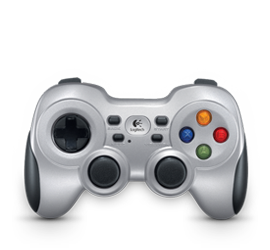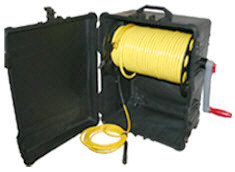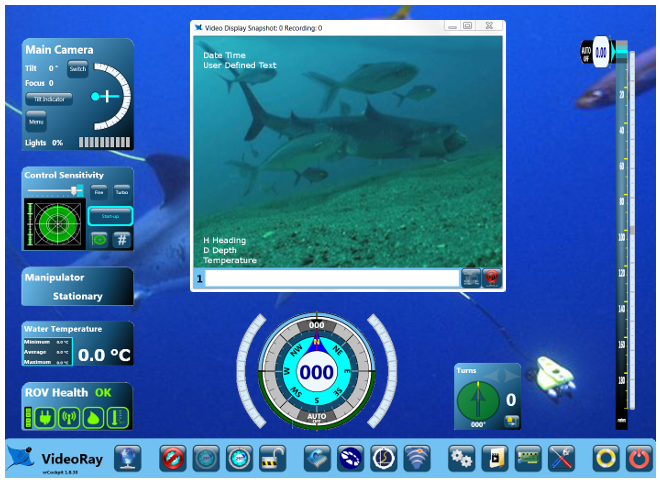Pro 4 Features and Capabilities UpdatesThe Pro 4 has been extensively updated to include many enhanced features and extended capabilities.Pro 4 User InterfaceThe Pro 4 includes a custom hand controller that is built using the same industrial controls found in the Pro 3 controller. This controller is delivered with a default configuration, but can be customized to accommodate any user's preferences. Additionally, any COTS or custom controller that works with a PC can be used with the Pro 4, including wearable and immersive devices such as gloves and head mounted display/controllers. Video can be displayed on two monitors, the built-in monitor and the PC display. Alternately, the video can be displayed on one screen while the other displays an accessory output such as a sonar or position tracking chart. The Pro 4 video can be recorded digitally (on the included PC), or using standard analog devices (user supplied), or both. Digital recording of still images and/or video is built into the control panel and can be executed with the push of a button on the controller. Digital recording is in industry standard formats and ready for non-linear editing, on-line sharing, or DVD authoring. The included PC can be configured to run accessory applications such as sonars, position tracking systems, VideoRay's radiation detector and other sensors. Sensor feedback is provided onscreen and includes the camera tilt and focus positions, lights setting, and information from other onboard sensors, including temperature, humidity, power and communications status. Pro 4 Power and Thruster TechnologyThe Pro 4 power supply has been upgraded from 48 Volts DC to 75 V DC, but still maintains the same low power consumption of the Pro 3 due to more efficient power circuitry. To support this increase safely, the Pro 4 incorporates a Line Insulation Monitor (LIM) protection circuit. Like a GFCI, the LIM detects minor changes that indicate a fault and safely powers down the system if a fault is detected. The voltage specifications at the accessory port have changed. The main bus is now 24 Volts DC, but it is isolated from the tether ROV power circuit and better regulated so that it is less susceptible to voltage variations under thruster load. The 12 Volt DC available on the accessory port is now capable of supporting loads up to 30 Watts instead of the 6 Watts available in the Pro 3. The VideoRay Pro 4 now includes custom designed and highly efficient brushless thrusters that deliver unparalleled performance and reliability. In order to provide the optimal blend of power and control, the VideoRay Pro 4's thrusters incorporate the following features:
Pro 4 CameraThe VideoRay Pro 4 is equipped with 2 high resolution color cameras. The main camera is located in the forward pressure hull and the second camera can be positioned on top of or underneath the ROV. The forward camera tilts 180 degrees while the second camera tilts 180 degrees and pans 360 degrees providing full hemispherical coverage. Both cameras are equipped with wide dynamic range and backlight compensation to deliver the highest quality images even in difficult lighting situations. The cameras are optimized for underwater use and offer ultra low-light sensitivity (0.0001 lux). There are more than 20 user controllable settings that can be managed from the surface including automatic or manual switching between color and black and white modes, an automatic shutter and digital zoom capabilities. Camera tilt and focus are now controlled using servo motors, which allow faster operation, precise positioning and feedback as to their current position. Position information for tilt and focus is displayed in the user interface. Pro 4 LightsThe new highly efficient and high intensity LED lighting provides 3,600 lumens at a color temperature of 6500K. This intensity and color temperature provides significantly improved penetration at depth. The intensity can be boosted to 5,700 lumens and LEDs with different color temperatures will be available in the future. The forward light reflectors have been engineered to distribute the light evenly throughout the camera tilt range, such that at 45 degrees vertically, the Pro 4 projects more light than other ROVs do straight ahead at the same distance. Like the Pro 3, the lights are positioned outside the main hull to provide the greatest separation from the camera and to make servicing easier (although the service rating of the LED lights makes servicing virtually unnecessary). This separation is extremely important in minimizing backscatter due to suspended particles in the path from the lights to the camera target, and results in higher quality images. The setting of the intensity of the lights is displayed in the user interface. Pro 4 Compass and NavigationThe Pro 4's navigation system includes a 3 axis compass, accelerometer, and MEMS Rate GYRO. These devices are mounted on a single board and are the same as one of the nodes in the KCF Technologies Smart Tether. You do not need to calibrate the compass. The heading of the ROV is displayed in the compass and its attitude (pitch and roll) in the attitude indicator. Pro 4 Depth GaugeThe Pro 4's depth gauge is much more sensitive and has about 10 times the resolution of the Pro 3's depth gauge. You do not need to calibrate the depth gauge. Auto-Pilot ModesAuto heading is now included in addition to auto depth, and both features now support the traditional "set and forget" mode and a new "go to" mode. Pro 4 Additional SensorsTemperature and humidity sensors have been added to the internal components of the Pro 4 ROV. Pro 4 Float BlockThe Pro 4 Float Block has been redesigned to be more hydrodynamic, more durable and provide variable floatation to match the accessory payload. Pro 4 Skid and Ballast SystemThe Pro 4 Skid and Ballast System have been redesigned to be stronger, more hydrodynamic and allow the ballast to be adjusted without requiring any tools. The system consists of a central accessory mounting adapter plate and two ballast weight pods. The weight pods are hinged and hold the ballast weights in slots that allow the pitch trim to be fine tuned. Pro 4 Depth RatingThe Pro 4 depth rating has been increased to 305 meters (1000 feet) by using a stiffer hull, but the overall weight of the Pro 4 has been reduced when compared to the Pro 3 GTO. |
|
|
|
Pro 4 Operator's Manual
Upgrader's Guide > Pro 3 Upgrader's Guide > Feature Updates






